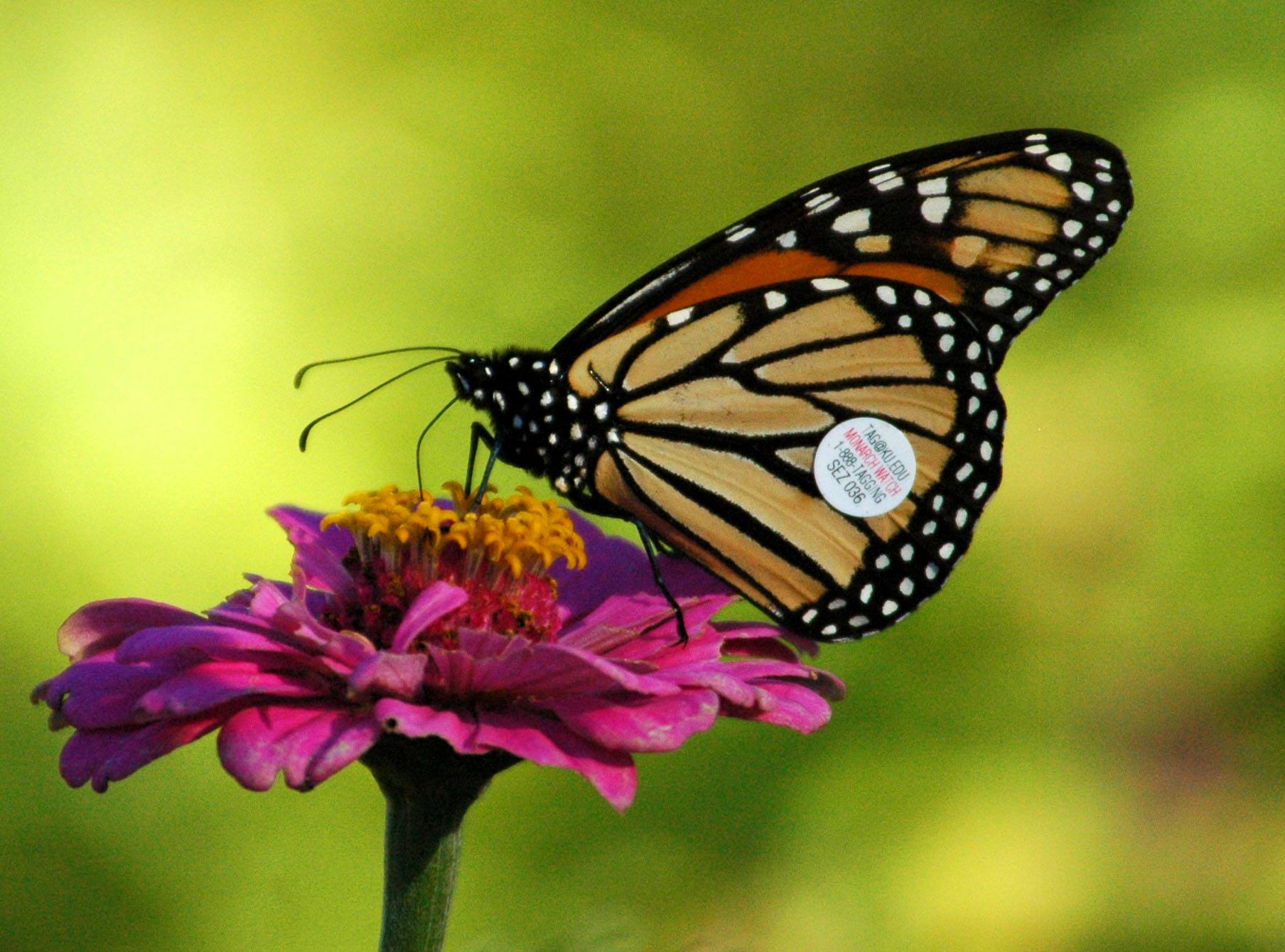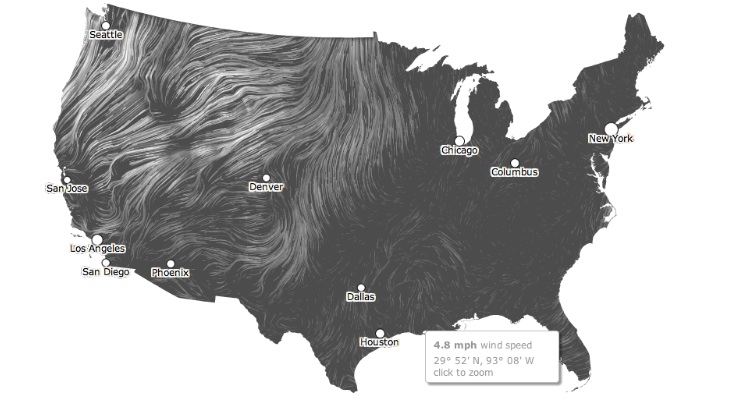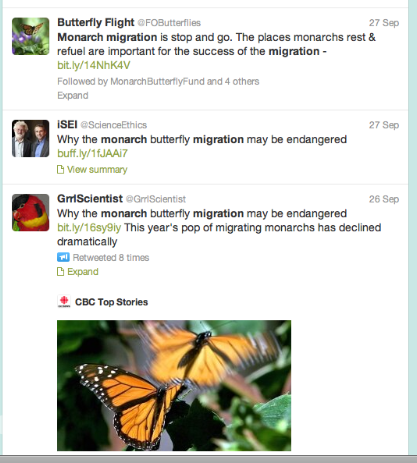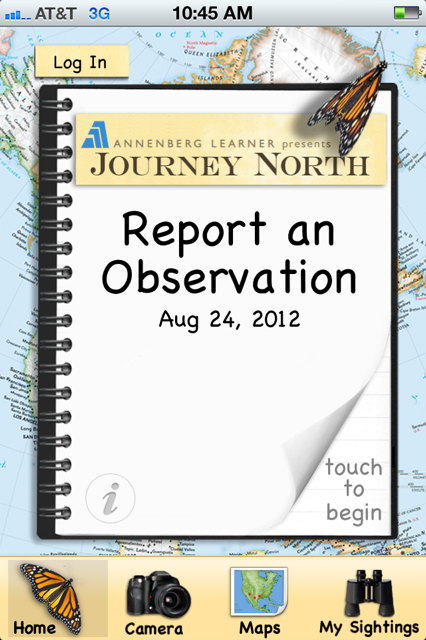With recent rains and cooling temperatures, we’re hearing some upbeat news about the Monarch migration. Numbers will doubtless be low this year–probably the lowest in history. That said, the migration is on. And in this historically low year, we’ll all be watching carefully.

“I took this photo today in Enid Oklahoma. 6 PM 9-28-2013.” — Carolene Metscher, Monarch Watch
Facebook Page
So as not to miss a (butterfly) beat, consider tapping into some of the cool digital tools available via the web. Sure, we’d all rather be outside with our butterfly nets half-cocked, a stash of Monarch Watch tags stuffed in our pockets with a notebook for logging the data of our most recent catch of the migrating creatures. But that’s not always possible.
At the intersection of technology and nature lies a host of tools to track the Monarch butterfly migration without ever leaving your desk. These myriad resources contribute much to citizen science.
A recent find for me is the wind map. I just love this website, which shows us in real-time how the winds are blowing.

For those of us who live in the Texas funnel, the wind plays an especially significant role in planning for Monarch tagging outings. I work full-time, so during Monarch season, I plot each weekend for maximum Monarch activity.
I check the Monarch Watch “peak migration” calendar, monitor the wind and weather, and poll my butterfly loving friends to see who might be available for a weekend of tagging on the Llano River. Lucky for me my birthday is October 13, which makes for a great Monika’s Monarch birthday weekend. This year will be no different. I will, however, consult the wind map to see what might be in store.
If winds are coming from the South, Monarchs won’t be moving much; that could mean they’re stranded in place, which could make for good tagging.
Winds from the North mean they’ll be riding the wave. And they have to roost at night, so that could also be good.
Twitter Search
Using Twitter as a search engine is another great Monarch butterfly tracking tool. It provides real-time updates of Monarch butterfly sightings. Granted, not everyone uses Twitter, “only” an estimated 200+ million people. For those who do and are interested in clocking the migration in real-time, it can be indispensable.
Twitter is a free, real-time search engine, as well as a broadcast outlet for individuals and organizations. That means you can visit http://search.twitter.com and punch in “monarch butterflies” or “monarch migration” or “monarch butterfly” and dozens of hours-old “tweets”–brief 140-character updates—will be returned, telling you where Monarchs are flying RIGHT NOW.

Check out Twitter search at http://search.twitter.com to see what’s happening with the Monarch migration RIGHT NOW.
Twitter was conceived as a mass text messaging tool, thus the brevity of the updates. It refreshes constantly. And to use Twitter as a search engine, you don’t even need to open an account.
Twitter search ONLY indexes recent updates. Google and other search engines are more akin to archives for the entire web. You can try searching Google News, but this won’t return the real-time reports Twitter delivers.
The results from these searches paint an immediate picture of what’s happening with the Monarch migration NOW. Yes, there’s junk in there, but also insights, relevant news stories, photos and facts. By clicking on the Twitterer’s profile, you learn their location.
Don’t scoff. Give it a try and check out this Twitter search for the Monarch butterfly migration.
Monarch Watch Facebook Page
If you’re reading this and you’re on Facebook, then you likely have already “LIKED” the Monarch Watch Facebook page. If not, go ahead, do it now, and join the party. (And while you’re at it, why not LIKE the Texas Butterfly Ranch Facebook page?)
With more than 12,400 fans, Monarch Watch’s page serves as a delightful online plaza where the Monarch Watch team from the University of Kansas engages with the rest of us to share information, photos, and wax passionate about Monarch butterflies and their migration. Citizen scientists, recreational observers, and professional and amateur biologists and entomologists join the conversation. Like this:
I almost always learn something from the Monarch Watch Facebook page. Here, veteran caterpillar wranglers offer wisdom born from hatched chrysalises, newbie enthusiasts pose curious questions and the sharp folks at Monarch Watch and the crowd set inaccuracies straight. The photos are often amazing, like the one taken by Carolene Metscher of Enid, Oklahoma at the top of this post. Nice shot, Carolene!
Billed as the nation’s premiere citizen scientist project for children, Journey North tracks wildlife migrations and seasonal change. This time of year, they post a weekly migration update on Thursdays based on observations from Monarch butterfly enthusiasts of all ages, from Canada to Mexico. Here’s an excerpt from Thursday’s report:
North Wind Continues
Migration picked up noticeably during the past week, as north winds carried monarchs southward. One busy stopover site was Dr. Lincoln Brower’s garden in Virginia, where a wave of monarchs arrived on September 18th:“Today was the first migratory pulse here. The monarchs are coming in to nectar on our Zinnias and especially the Verbena. I saw and/or collected 25 monarchs in 50 minutes in the garden. I scanned the sky with binoculars but never saw them flying in. They just suddenly appear on the flowers!”
The Journey North website offers loads of useful tools and resources for teachers and others on the Monarch butterfly migration, including an app at the iTunes store.
Monarch Watch Website
Journey North devotes itself to wildlife migrations besides Monarch butterflies (they also monitor hummingbirds, whales and birds), but the Monarch Watch website brags Monarch butterflies, all the time.

Based at the University of Kansas at Lawrence, Monarch Watch founded the citizen scientist tagging program embraced by thousands of us who tag Monarchs each fall. Its comprehensive website offers information on how to tag a Monarch, raising milkweed, rearing Monarch caterpillars, and a database of all the Monarch tags recovered in Mexico, so those of us who tag can find out if any of our butterflies made it home.
The site also posts predictions for when the peak migration will occur at your latitude based on Monarch Watch scientists’ well-researched opinions. The Monarch Watch blog is also worth a look.
D-Plex List
If the above won’t sate your migration curiosity, then consider signing up for the D-PLEX list, an email exchange that includes about 650 scientists, conservationists, enthusiasts, and others, including some very interesting characters.
Named after the Monarch butterfly’s Latin designation, Danaus plexipus, the D-PLEX is an old fashioned email listserv started by Monarch Watch founder Dr. Chip Taylor and invites the public. Sign up to receive D-PLEX emails on the Monarch Watch webpage.
Careful, though. The D-PLEX can overtake your email inbox. Conversations can escalate, generating dozens of emails a day, many of which you may not find useful. I’ve set up all D-PLEX emails to forward to a special email box that I check once a day, so as not to be overwhelmed.
Don’t forget to check in with us here at the Texas Butterfly Ranch, too. We’ll do our best to keep you posted.
More posts like this:
- Fall Equinox Kicks off Meager Monarch Butterfly Migration
- How to tag Monarch Butterflies
- Monarch Butterfly Google Earth Tour
- Monarch Butterflies: the Panda Bears of Climate Change?
- Tracking the Monarch Migration from Your Desk
- A Year in the Life of a Mostly Native Urban Butterfly Garden
- As the Earth Heats Up, What Does it Mean for Monarch and other Migrating Butterflies?



Leave A Comment